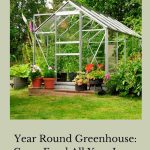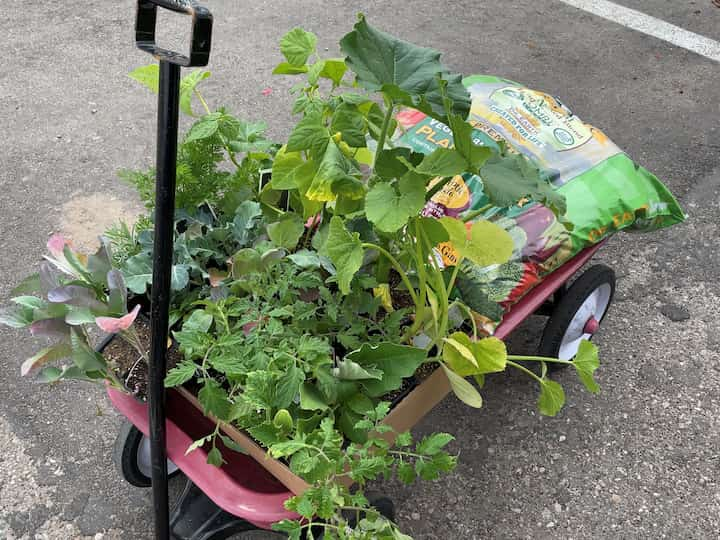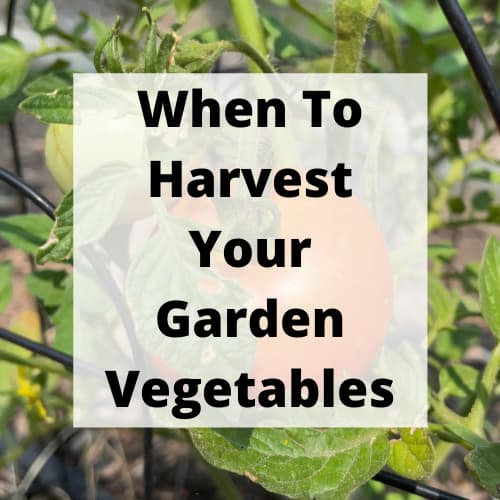Year Round Greenhouse: Grow Food All Year Long
Year Round Greenhouse: There’s a common misconception that you can only grow food in your garden during the warm sunny months. Granted, spring and summer are where you see most cultivation, but it’s more than possible to grow things at other periods.
This post may contain affiliate links, I earn from qualifying purchases at no extra cost to you. Click here for my disclosure policy
Actually, it’s possible to grow food in your garden throughout the whole year!
That’s right, you can have twelve months of fresh produce growing in your backyard whenever you want it. And here’s the best thing – you’re going to learn exactly how to do this in the post below.
Keep on reading and you’ll find some actionable tips for year-long gardening:

Understand seasonal gardening
Table of Contents
- 1 Understand seasonal gardening
- 2 Utilize a greenhouse
- 3 Ensure you’re succession planting
- 4 Implement protection measures
- 5 What can I grow in my home greenhouse year-round?
- 6 What’s the best kind of greenhouse for year round weather?
- 7 How do you make a greenhouse work in the winter? Will a greenhouse keep my plants from freezing?
- 8 Keep at it
A lot of fruits and vegetables love growing in the warm air. They need lots of sunlight and are only good to grow during the summer months.
On the other hand, plenty of vegetables thrive in colder conditions. Some veggies need a bit of coldness and do way better in rugged climates. You’re mainly targeting hardy crops here like kale, beetroot, turnips, carrots, and broccoli.
If you want to grow things throughout the year, it helps to know the best things to grow at certain points. This is called seasonal gardening and it has plenty of benefits. For one, you get the benefit of supplying fresh fruit/veg every month. Secondly, because you plant things that thrive at different points in the year, they’ll always taste their best!
So, head to Google and start doing some research. Find foods that grow well in summer, fall, winter, and spring. From here, you can plan what you’ll grow in different parts of the year. The end result is a garden that’s always filled with tasty things to eat or sell.
Utilize a greenhouse
If you can only add one thing to your garden, it should be a luxury greenhouse. This is the secret to growing food in your yard for twelve months of the year. Not only that, but it will help you extend the growing season of many summer plants, so you can enjoy them later or earlier in the year.
For those that aren’t aware, greenhouses are more than just glass rooms. Sure, they look pretty, but they’re designed to do something special. They provide you with covered areas to grow produce. What’s more, they create an atmosphere that encourages the growth of many kinds of fruit and veg.
If you’ve ever stepped inside a greenhouse, you’ll know how warm and humid it can get. Combined with regular watering and this creates the perfect tropical or Mediterranean growing conditions. You’re able to plant and grow things you’d never be able to grow outside because of weather conditions.
In theory, you can use heating systems to control the climate in a greenhouse so summer loads can be grown during the winter. This is perfect for people with small gardens that want to extend the summer growing season – but it’s also great if you have a large garden area. You can continue growing summer fruit/veg in your greenhouse while using the uncovered areas of your garden for winter crops.
Ensure you’re succession planting
No, this has nothing to do with the hit HBO show.
Succession planting is all about getting new plants ready when old ones are done. It’s pretty much gardening 101 for anyone interested in being self-sufficient. The moment one of your crops is finished, you should replace it with a succession crop. These crops are planted mid-season and will be ready before you know it.
You can replace crops with the exact same fruit/veg (depending on where you’re at in the growing season) or you can plant things that will be ready for the next season. It’s completely up to you, but the idea is that you get ahead of yourself and always ensure something is growing.
Again, greenhouses come in handy here as you can use them to plant seeds and get a few bulbs growing nicely. So, when one crop is over, you transfer the new bulbs to the soil and they’ve already got a head start.
Implement protection measures
Sometimes, the seasons don’t go as intended. You expect the summer to be warm and dry but have large periods of torrential rain. This can wreak havoc on your crops as they’re being over or understimulated.
One way to tackle this is by protecting your crops from the elements. Keep an eye on the weather forecast and see if it’s going to rain. If this is the case, use row covers or other crop protection products to protect your food from rainfall. This will ensure they’re not overwatered and the roots don’t suffocate.
The same goes for other weather conditions too – like excessively cold. If a really cold frost hits, it can ruin some of the growth potential of your crops, even those designed to grow in the winter. If you use cold frames or various other tools you can protect crops from frost and keep them growing healthily.
It’s all about understanding the weather forecast and reacting to give your crops the best chance of life!
Shop any of these stores and I receive a small commission at no cost to you.
 Ohuhu Greenhouse for Outdoo...Shop on Amazon
Ohuhu Greenhouse for Outdoo...Shop on Amazon The Old Farmer's Almanac Ve...Shop on Amazon
The Old Farmer's Almanac Ve...Shop on Amazon Gardening Tool Set, CHRYZTA...Shop on Amazon
Gardening Tool Set, CHRYZTA...Shop on Amazon
What can I grow in my home greenhouse year-round?
A home greenhouse provides a controlled environment that allows you to extend the growing season and grow a variety of plants throughout the year. Here are some options for crops that you can grow in your home greenhouse year-round:
- Leafy greens: Varieties like lettuce, spinach, kale, and Swiss chard are ideal for greenhouse cultivation. They have relatively short growing cycles and can tolerate cooler temperatures.
- Herbs: Many herbs, including basil, parsley, cilantro, mint, and thyme, can be grown in a greenhouse year-round. They require moderate temperatures and ample sunlight.
- Microgreens: Microgreens are young, tender seedlings of various vegetables and herbs. They are harvested when they have developed their first true leaves. You can grow microgreens like radish, broccoli, mustard, and sunflower in trays or containers.
- Tomatoes: With proper care and support, you can grow tomatoes in a greenhouse throughout the year. There are determinate varieties that work well in smaller spaces, while indeterminate types can be trained to grow vertically.
- Cucumbers: Cucumbers thrive in the warm and humid conditions of a greenhouse. You can grow compact varieties or use trellises to support vining types.
- Peppers: Both sweet peppers and hot peppers can be grown in a greenhouse year-round. They require warm temperatures and benefit from regular pruning and support.
- Strawberries: Certain strawberry varieties are well-suited for greenhouse cultivation. They can be grown in containers or hanging baskets, allowing for easy maintenance and harvesting.
- Beans: Bush beans or pole beans can be grown in a greenhouse. Pole beans may require vertical support, while bush beans are more compact and suitable for smaller spaces.
- Radishes: Radishes are fast-growing root vegetables that can be cultivated year-round in a greenhouse. They prefer cooler temperatures and mature relatively quickly.
- Mushrooms: If you’re interested in growing fungi, mushrooms can be cultivated in a controlled environment like a greenhouse. There are different mushroom species to choose from, such as oyster mushrooms or shiitake mushrooms.
Remember to consider the specific requirements of each plant, such as temperature, light, humidity, and spacing, to create the ideal conditions in your greenhouse for successful year-round growth.
What’s the best kind of greenhouse for year round weather?
The best kind of greenhouse for year-round weather depends on various factors, including your specific climate, budget, available space, and the types of plants you intend to grow. Here are a few greenhouse options that are commonly used for year-round cultivation:
- Glass greenhouse: Glass greenhouses are known for their excellent light transmission and durability. They provide a stable environment, retain heat well, and resist temperature fluctuations. Glass is also easy to clean and maintain. However, glass greenhouses can be expensive to build and require a sturdy frame to support the weight of the glass panels.
- Polycarbonate greenhouse: Polycarbonate is a lightweight and durable material that provides good insulation and diffuses light, reducing the risk of scorching plants. Twin-wall or multi-wall polycarbonate panels offer improved insulation properties. Polycarbonate greenhouses are often more affordable than glass and are available in different thicknesses to suit various climates.
- High tunnel or hoop house: High tunnels, also known as hoop houses, are simple structures with a curved or semi-circular frame covered with polyethylene plastic. They are relatively cost-effective and easy to assemble. High tunnels provide protection against the elements, extend the growing season, and can be used year-round with proper management. However, they may require additional heating in colder climates.
- Insulated greenhouse: Insulated greenhouses are designed specifically for year-round use and provide enhanced energy efficiency. They typically feature insulated walls, roof, and floor, along with double or triple glazing. Insulated greenhouses help regulate temperatures, reduce heat loss, and often require less supplemental heating in cold weather.
- Solar greenhouse: A solar greenhouse is designed to harness solar energy for heating and reduce reliance on additional heating systems. It utilizes passive solar techniques, such as strategic orientation, thermal mass, and insulation, to maximize heat retention. A well-designed solar greenhouse can significantly reduce heating costs and maintain a more consistent temperature throughout the year.
Remember that the best choice for your specific circumstances will depend on your budget, location, available space, and intended use. It’s important to consider factors such as insulation, ventilation, heating options, and the structural integrity of the greenhouse to create a suitable environment for year-round growing. Consulting with local greenhouse suppliers, horticultural experts, or experienced gardeners in your area can provide valuable insights tailored to your specific climate and needs.
How do you make a greenhouse work in the winter? Will a greenhouse keep my plants from freezing?
A greenhouse can provide protection against freezing temperatures, but it depends on the type of greenhouse and the measures you take to maintain a suitable climate inside. Here are some factors to consider:
- Insulation: A well-insulated greenhouse will help retain heat and protect plants from freezing temperatures. Materials such as double-walled polycarbonate or glass are better insulators than single-pane glass or plastic sheeting.
- Heating: Depending on your climate and the severity of cold temperatures, you may need to provide supplemental heating in your greenhouse. Heating options include electric heaters, propane heaters, radiant heating systems, or even geothermal heating. A thermostat or temperature controller can help maintain the desired temperature range.
- Ventilation: While it’s important to keep the greenhouse warm, proper ventilation is also crucial to prevent excessive heat buildup and maintain air circulation. Greenhouses should have vents or windows that can be opened to release excess heat and humidity.
- Thermal mass: Incorporating thermal mass, such as water barrels or stone walls, inside the greenhouse can help absorb and store heat during the day and release it at night, providing some protection against freezing temperatures.
- Cold frames and row covers: Adding additional layers of protection within the greenhouse can be beneficial during extreme cold spells. Cold frames can be placed inside the greenhouse to create an extra barrier, and row covers or frost blankets can be used to shield individual plants.
- Monitoring: Use a thermometer or a climate monitoring system to keep track of the temperature inside the greenhouse. This will help you identify any potential issues and make adjustments as needed.
It’s important to note that while a greenhouse can provide insulation against freezing temperatures, extremely low temperatures or prolonged cold spells may still require additional measures or specialized greenhouse designs to maintain optimal growing conditions.

Keep at it
If you want to grow things throughout the year, you need to be gardening throughout the year too.
Keep at it and ensure you’re outside looking after your plants, dealing with weeds, laying down mulch, and so on. A lot of gardeners complain that they can’t grow certain fruit/veg very well. This is usually because they plant the seeds and then leave them. You have to be an active gardener who looks at your plants, tops up water levels, provides more nutrients, etc. The more active you are, the more things will grow.
As you can see, it is highly possible to grow lots of nice produce at all points in a year. Don’t be fooled into thinking your garden can only supply fresh food during the summer months. With a few tips and tricks, you’ll be more self-sufficient! Overall, this can help you save a lot of money on groceries while making your garden look colorful and gorgeous throughout the year.








